An Adventure Below Makalu—2000
By sheer coincidence, Scotsman Donald Devine and I happened to arrive in Katmandu,
Nepal, on November 4, 2000 with the thought of trekking to Makalu! We had trekked
to Kangchenjunga two years before, then lost contact with each other. So we joined
together again and set out on another 28-day epic, this time to Makalu—the
world's fifth highest summit—located east of Everest.
We were not alone. Our organized trek had a crew of 15 to carry all of our food
and gear for the long trip. Why so many people for just us two trekkers? That was
just the way the Nepalese do things. The agency Nepal Vision
www.nepalvisiontreks.com put everything
together in just two days and we were on our way. The cost worked out to $44/day
for each of us—a good deal as everything was included. It's nice to have someone
carry your backpack on the steep and slippery trails, not to mention having a kitchen
team fixing three cooked meals every day!
Click on the photos for a larger view!

We start our long walk in the market town of Hile in eastern Nepal. An overnight
bus ride had deposited us here, slightly worse for the wear, at sunrise. We cross
a ridge, then began a long descent toward the Arun River. A check on the short-wave
radio brings in the first U.S. election results.
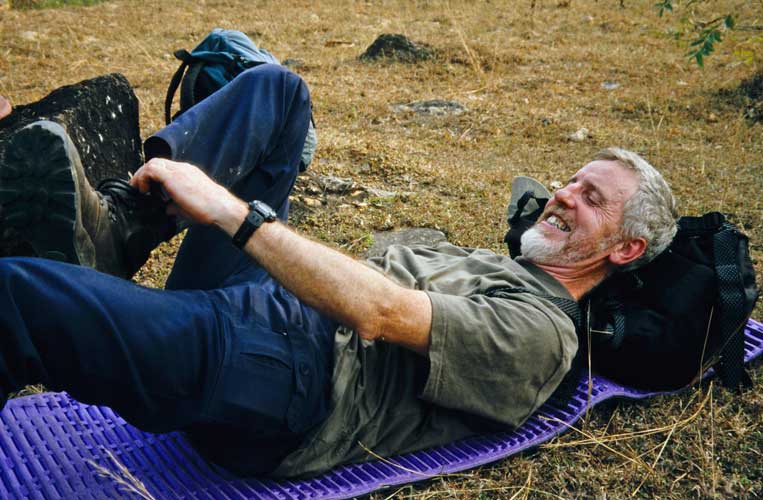
Ah, day's end! Donald takes a rest while our cooks fix dinner.
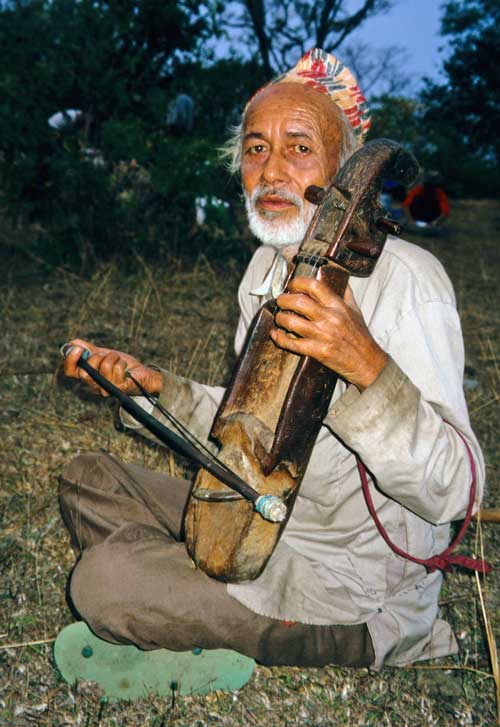
A gaaine. This wandering minstrel plays a primitive fiddle and sings topical and
entertaining songs. Only a few gaaine still wander the hills, now that nearly every
family has a radio.

The next morning we cross this bridge over the Mangmaya Khola to the village of
the same name. Weather is warm, hazy, and partly cloudy. The skies will become increasingly
cloudy and cooler over the coming days.

Our crew loves singing and dancing to popular Nepalese tunes. Unlike Western pop
music with its harsh words, Nepalese music is generally happy. One of the favorites
with the young people is actually a Hindu devotional song. Here we are enjoying
the sunshine 11 days into the trip. We've entered the high in hills inhabited by
the Sherpa people. Ethnic groups of our crew include Sherpa, Rai, Newari, Tamang,
and even a Hindu Brahmin. I was amazed that they always got along well together
despite differences in religion and ancestry. They are all Nepali!
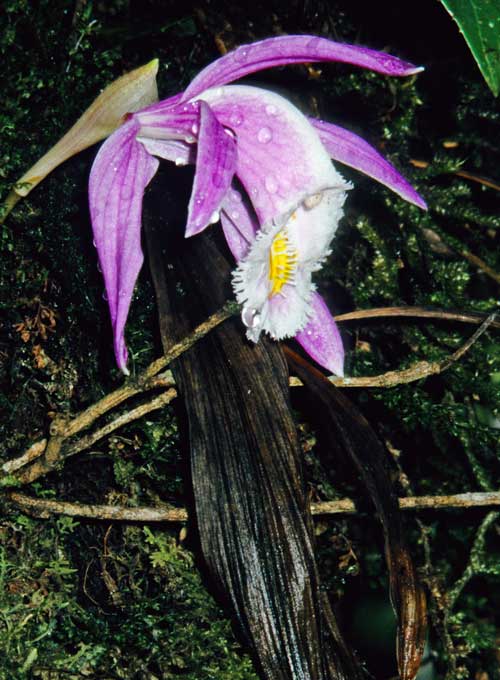
Many orchids and other flowers hang from the moss-clad trees along a faint jungle
trail to the Sherpa village of Tashigaon, the last village we would see on the way
to Makalu Base Camp.

Donald heads up the trail on another glorious sunny day. We've left Tashigaon for
the high mountains.
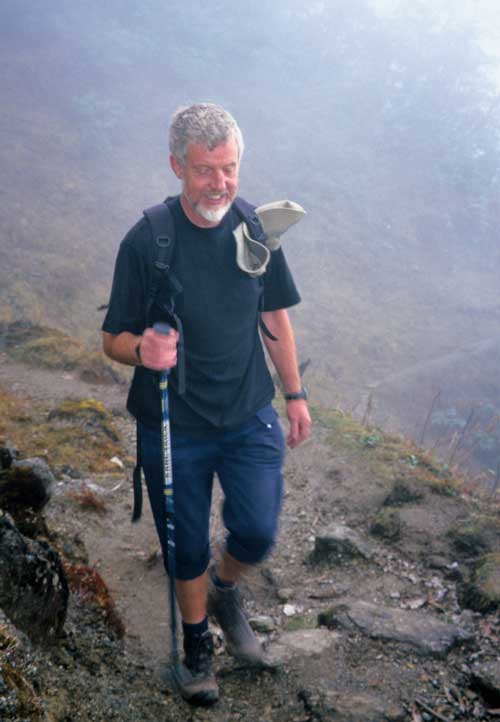
Unfortunately, the clouds take over when we reach the ridge at Khongma (3560 meters).
Snow arrives during the night.

Climbing the ridge from Khongma past Kalo Pokari. We camp in the snow at Dobatak,
but the weather continues to get worse and we retreat the next day. Our porters
don't have the gear for so much snow.
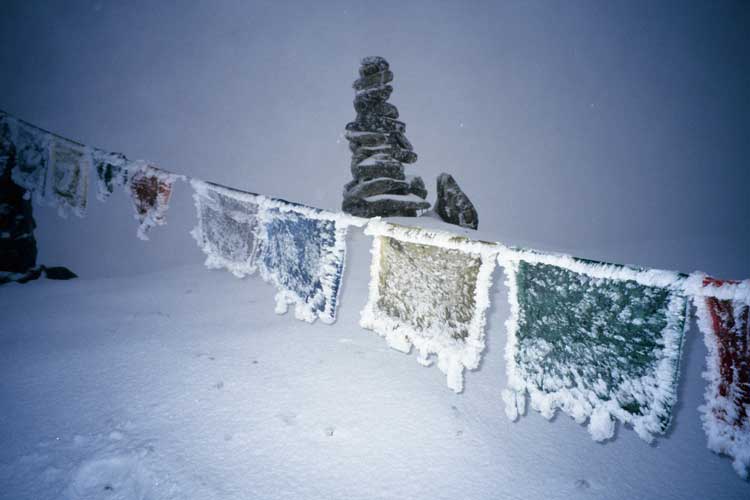
Hoarfrost coats the prayer flags at Shipton La, named after a British mountaineer.
I have to use flash at midday because the clouds are so thick. This is the highest
at 4429 meters (13,875 feet) of the three passes that we crossed between Khongma
and Dobatak.
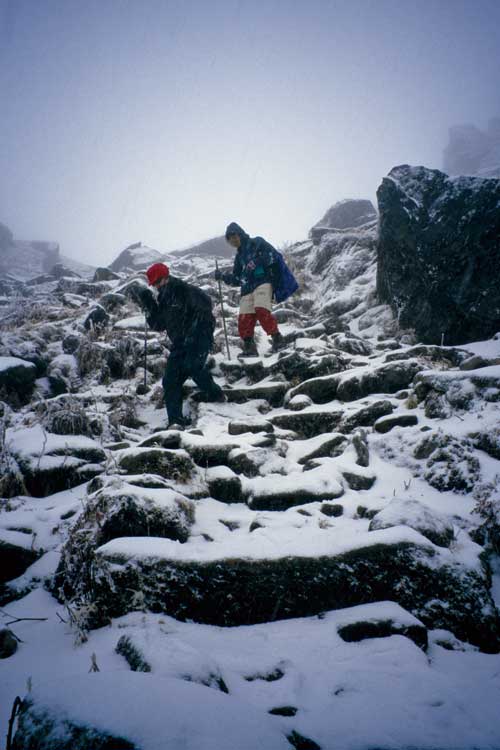
Donald and our guide Subha descend the Shipton La in a snowstorm. Luckily we manage
to stay on the trail. The wind is howling at Khongma, so we continue the long descent
to Tashigaon through slush and rain. Donald's sleeping bag is soaked, as are his
spirits. We stay in a bamboo-roofed lodge that night.

Walking through Narbugaon. Gardens envelope this picturesque Sherpa village. Our
assistant guide Pemba is from here and his wife had just had just given birth to
a baby boy.
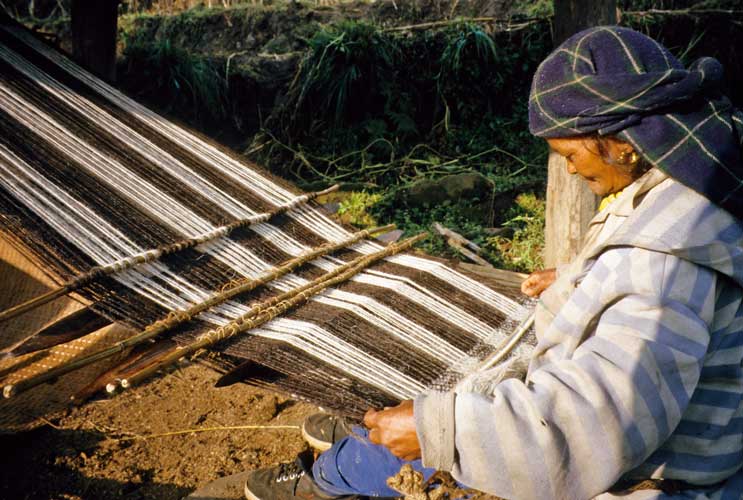
Houses tend to be smoky because they usually lack chimneys. This weaver is enjoying
the fresh air outdoors in Narbugaon. The nearest well-stocked shop is several days
away and the mountain people have little cash, so they produce most of their necessities.

Kids are curious about us strange Westerners!

Donald having a cup of chang, the local beer, inside the smoky house with Pemba
(far left). Our guide Subha (on the right in back) is smiling, not knowing of his
coming disaster. Pemba, Subha, and our cook (also Pemba) stay behind in Narbugaon,
then fail to catch up with us as we trek over precarious trails to our night's camp.
Subha, perhaps with too much chang and in too much of a hurry, takes a bad fall
coming down a steep hillside. The two Pembas were too far ahead to hear his cries.
The battered Subha, dazed and bleeding from a gash below his right eye, spends a
frigid night under the stars alone. He is too weak even to get up and find his pack.
The next morning he is found and brought to camp, where we clean him up.

We wait a day for Subha and the others to catch up at the Sherpa village of Mayum.
Snow peaks near Makalu shone in the morning before the clouds built up. I take a
short dayhike down the valley to visit another village and see the scenery. Although
these villages are very pretty, the people are poor and have to walk many days if
they need medical help or other supplies. The government does have primary schools
here, though the teacher I talk to finds it a hardship post.
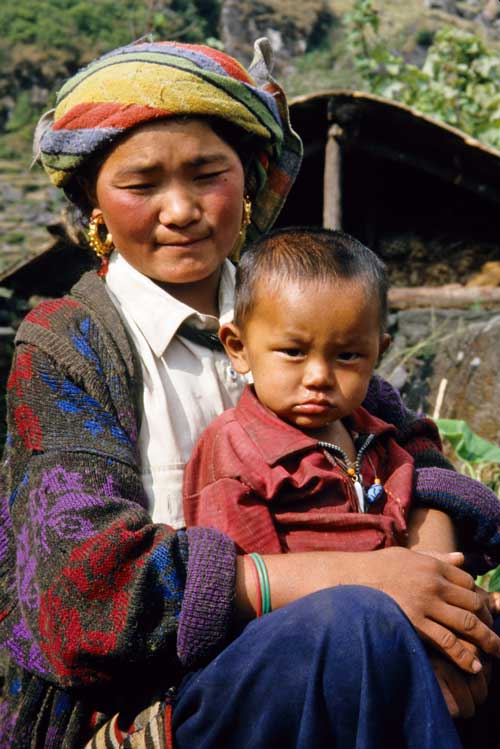
A Sherpa woman with her baby in Yangluwa village, watches people passing by on the
trail.
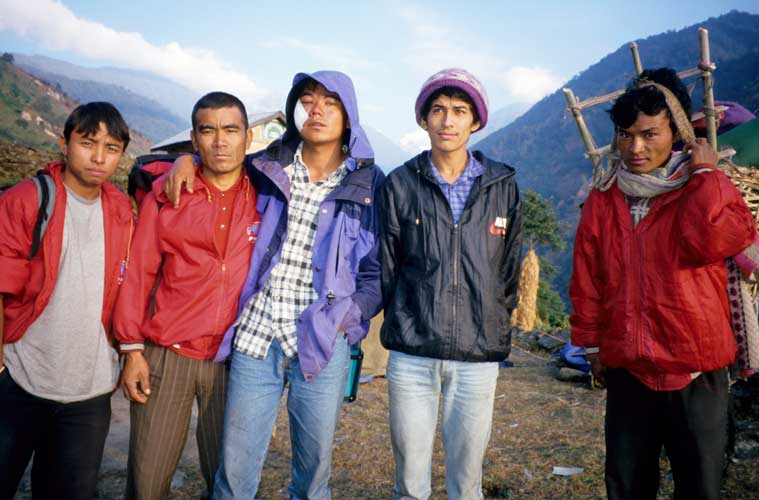
The next morning, Subha is able to walk, though porters make a basket to
carry him if necessary. Subha goes with four porters down the valley to
Tumlingtar in several days, then flies to Katmandu. He'll be OK.
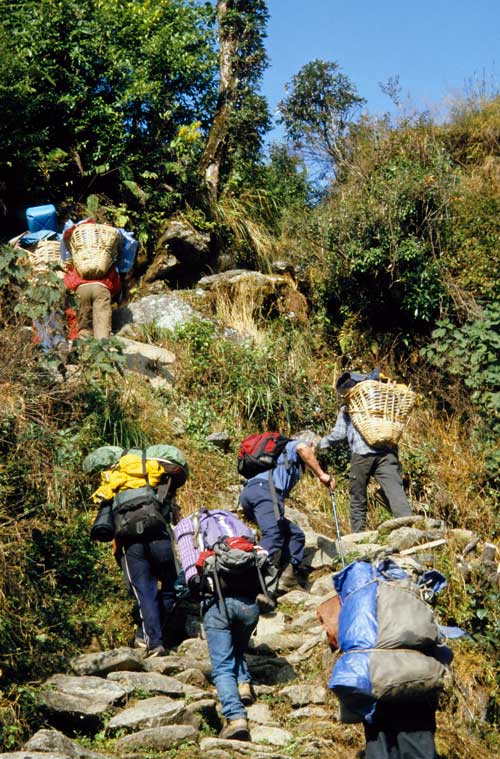
Trails are rarely level in Nepal, but that doesn't bother the Nepalese! We continue
the trek by climbing a high, jungle-covered ridge to the west. On the other side,
we have to cross a raging river on a very flimsy log bridge, some of which is being
lapped by the waves.
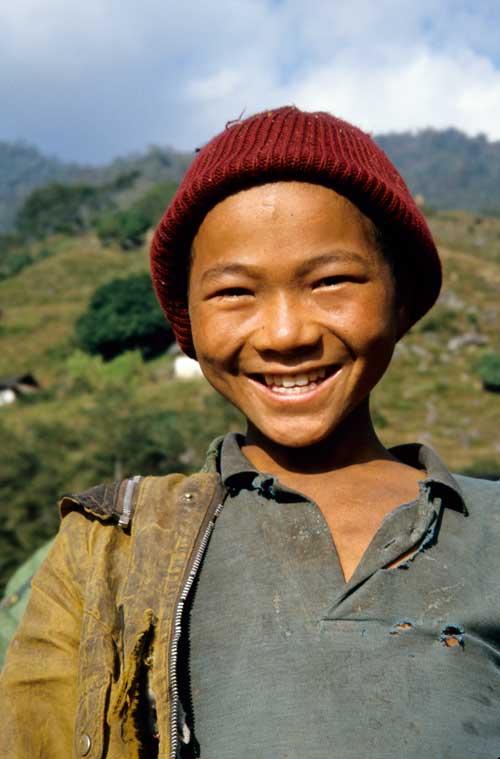
The people make trekking in Nepal especially enjoyable. This boy lives in the Sherpa
village of Narbuchaur.

Not everyone can smile with a heavy pack and a long jungle trail ahead, but our
porters can! They aren't getting rich with a pay of several dollars per day. Many
are married and away from their families. For food, our crew is happy with a huge
pile of rice, some vegetables, and tea; they prefer to eat just twice a day—late
morning and evening.

Prem on his double-ended drum. A student in Katmandu, Prem had been hired as an "extra"
to carry loads and help serve food. After Subha's accident, Prem took over as our
guide, yet continued to carry a heavy load and serve food! He's very talented at
Nepali and Hindi dancing.
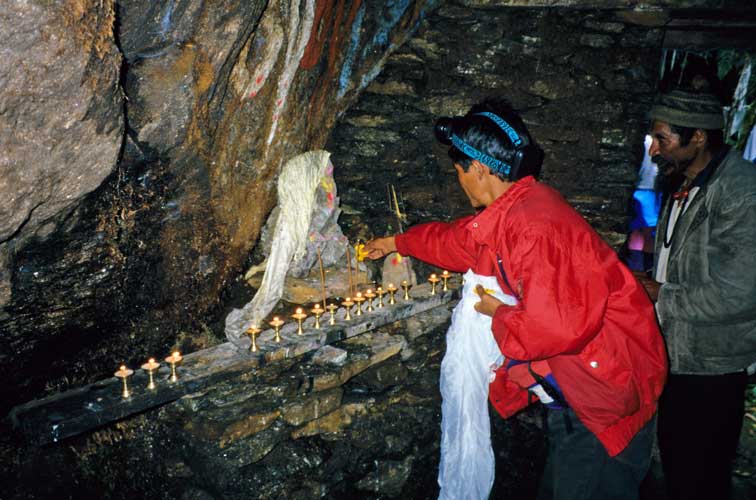
Shrine near the entrance to Khembalung Cave. Trekking companies give no refunds
for bad weather. We still had two weeks left after turning back in the snowstorm,
so the question was where to go. My guidebook described a little-used route west
to the sacred Khembalung Cave. So we took the rugged jungle trails to this site.
The cave is sacred to both Hindus and Buddhists. We felt the spiritual power of
the spot, set in a beautiful forest above the Sherpa village of Dobatak. Certain
rocks, such as this one covered with kata cloth offerings, correspond to gods or
important lamas.
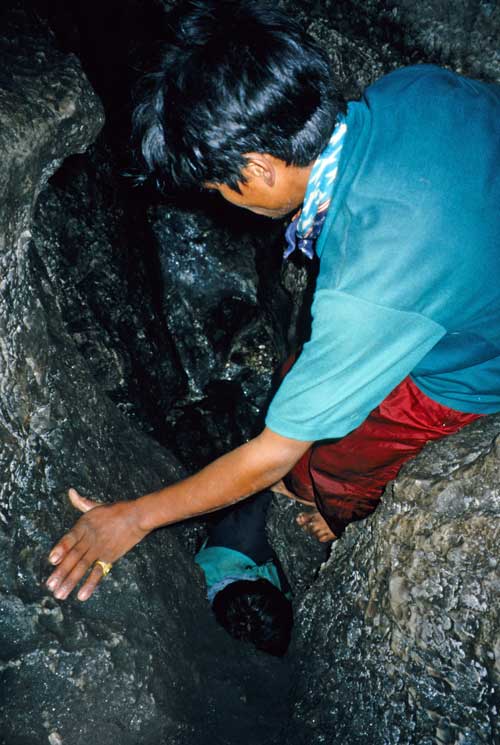
We climb down the tight passages of Khembalung Cave to a small stream, then exit
at another opening.
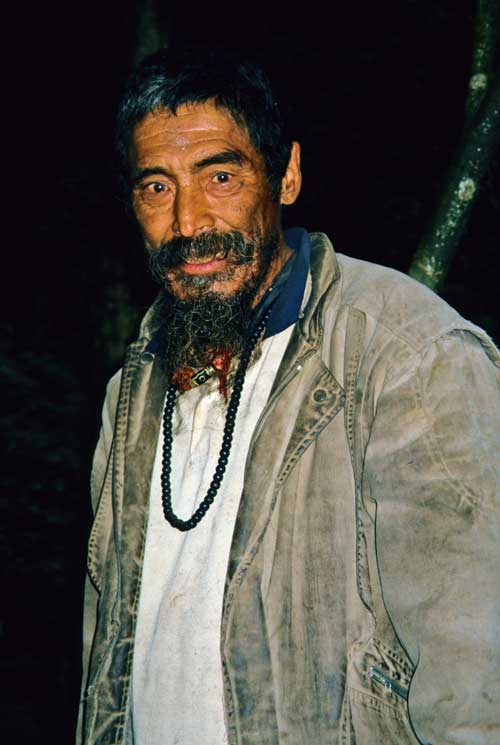
The friendly local lama led us through the cave.

The jungle has many botanical and aqueous delights, such as this small pool and
waterfall.

We descend from the jungle back to warm valleys and rice fields.
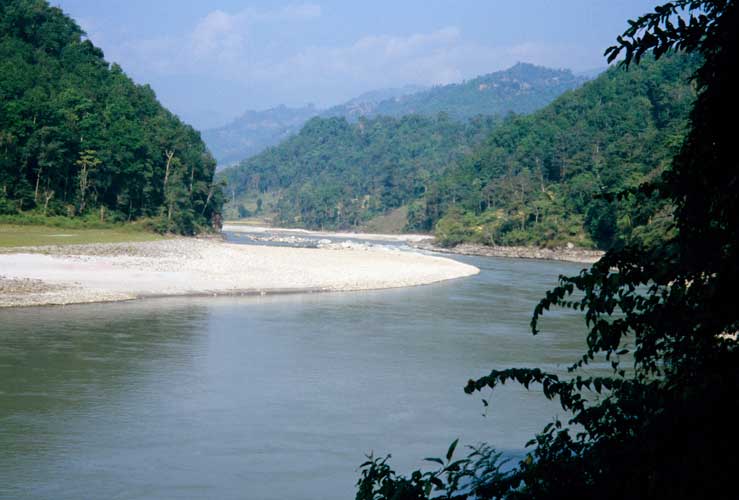
We finally reach the broad Arun River, one of the Himalaya's largest. Bananas grow
in the warm climate here.

Our cook Pemba picks up some huge bananas in the market at Kharang. They are very
tasty!

This man is making a mold for a brass water pot in Chainpur, a district center in
the hills of eastern Nepal. He's Newari, a group that believes in both Hindu and
Buddhist teachings.

Rock slabs pave Chainpur's street. The town has multi-story buildings and electricity,
yet is far from the nearest road.
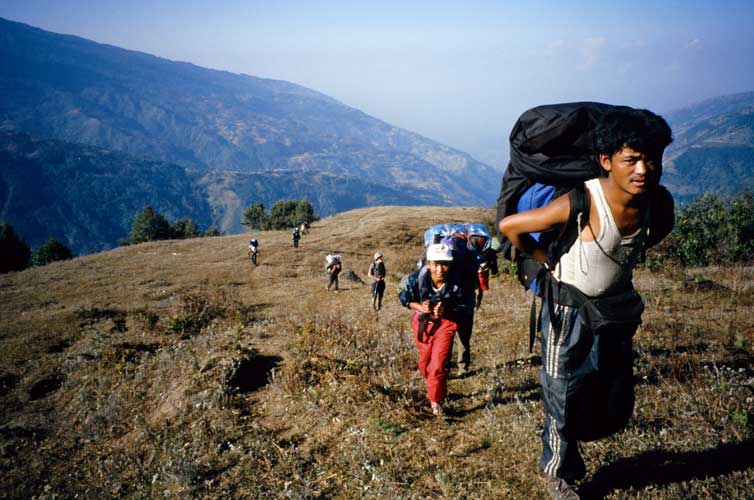
The Arun River lies far below as we climb to the Milke Danda ridge. Nights are frosty
now. The sun feels great.
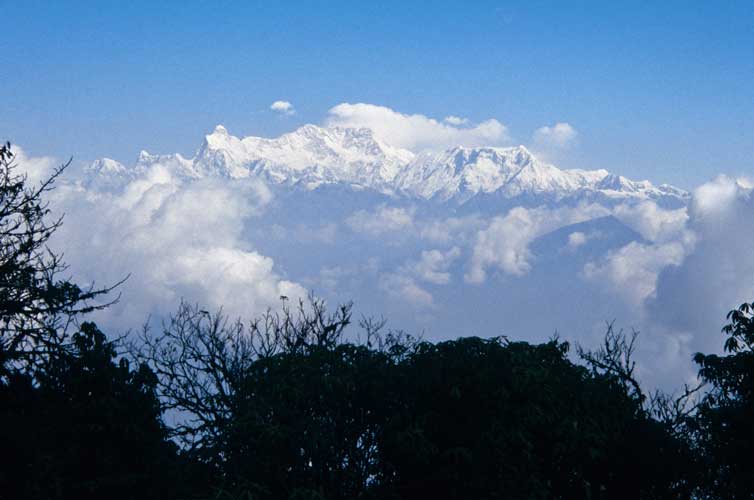
A view of Kangchenjunga rewards us when we crest the ridge. Now we turn south along
the ridge toward trail's end at Basantapur, not far from our starting point of Hile.

Blazing blue skies and bracing cold air accompany us on our next-to-last trekking
day.
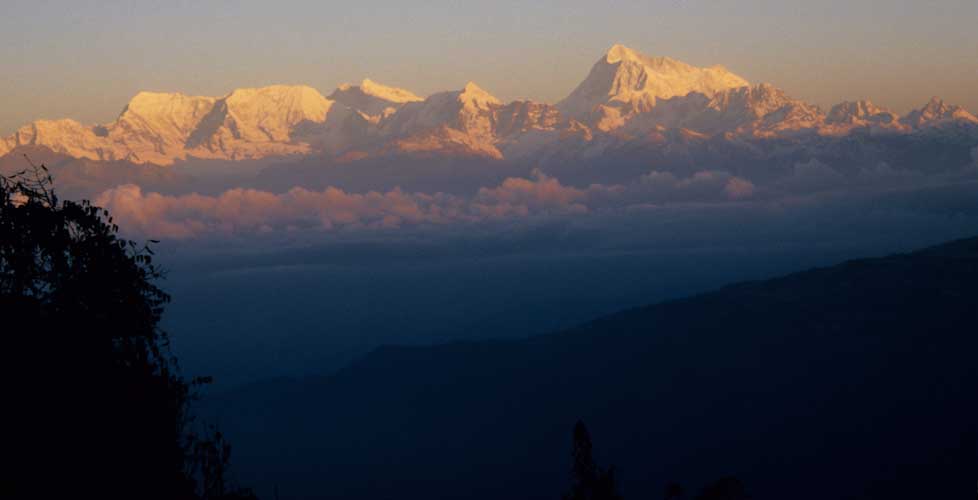
A Makalu sunrise on our last trekking day. The mountain that so evaded us now looks
so close.

The tiny village of Panch Pokari clings to the ridgetop. From here we follow a wide
trail to Basantapur and a short, bouncy bus ride to Hile, where we have a belated
lunch. Our cook pulls out all the stops for a big dinner with chocolate cake that
night. The next day we take the bus back to Katmandu, shaking our bones and freezing
our skin on the way. But we survive and will be back for another trek.
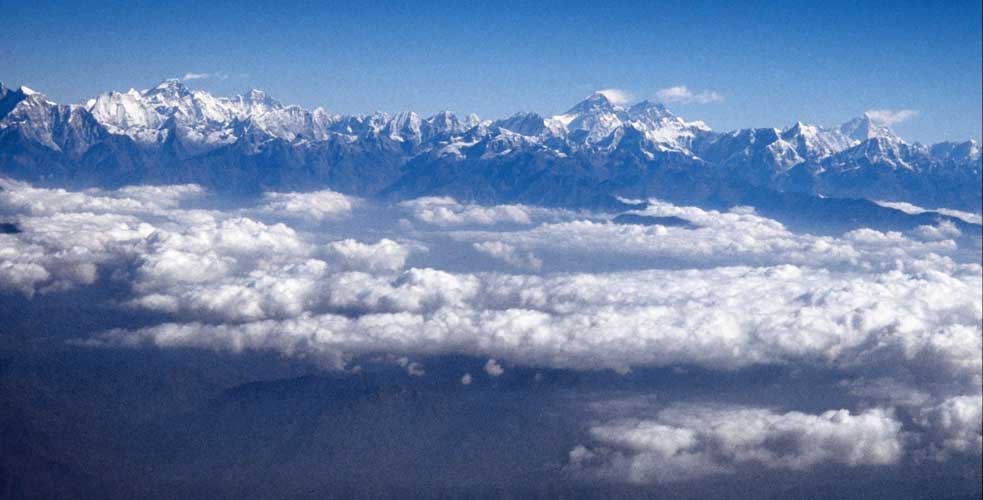
The Himalaya puts on a grand show on the flight back to Bangkok. The plumed peaks
from left to right are Cho Oyu, Everest, Lhotse, and Makalu—all over 8,000
meters.




































